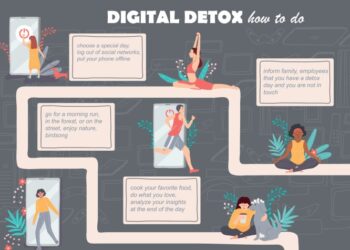In a world where technology plays an ever-increasing role, the concept of Digilife is reshaping daily routines on a global scale. From smart devices to automation, this topic delves into the various ways in which digital tools are influencing our day-to-day activities.
How Digilife Impacts Daily Routines
Digilife refers to the integration of digital technologies into various aspects of daily life, fundamentally transforming how people go about their routines on a global scale. The influence of digital tools has significantly altered habits and behaviors in numerous ways.
Reshaping Communication
- Instant Communication: The rise of smartphones and social media platforms has made it easier for individuals to stay connected with others in real-time, regardless of geographical barriers.
- Virtual Meetings: Video conferencing tools have replaced traditional face-to-face meetings, allowing for more flexibility and efficiency in communication.
- 24/7 Connectivity: People are now constantly reachable through emails, messages, and notifications, blurring the lines between work and personal life.
Changing Work Dynamics
- Remote Work: The ability to work from anywhere has become increasingly prevalent, offering flexibility but also blurring the boundaries between work and home life.
- Digital Collaboration: Teamwork has evolved with the use of collaborative tools like Google Docs and Slack, enabling seamless sharing of information and ideas.
- Increased Productivity: Automation and digital tools have streamlined work processes, leading to higher efficiency but also potentially contributing to work-related stress.
Impact on Health and Well-being
- Fitness Tracking: Wearable devices and health apps have revolutionized the way people monitor their physical activity and overall health.
- Social Media Influence: The constant exposure to curated lifestyles on social media can impact mental health and self-esteem, leading to feelings of inadequacy or FOMO (fear of missing out).
- Sleep Disruption: Excessive screen time before bed has been linked to sleep disturbances and reduced sleep quality, affecting overall well-being.
Innovative Technologies in Daily Tasks
As technology continues to advance, innovative solutions have emerged that are reshaping the way we approach our daily routines. These technologies have the potential to simplify tasks that were once time-consuming or complex, but they also come with their own set of challenges.
Smart Home Devices
Smart home devices, such as virtual assistants like Amazon Alexa or Google Home, have revolutionized the way we control and manage our homes. These devices allow users to control lights, thermostats, and even home security systems with simple voice commands, making daily tasks more convenient and efficient.
- Traditional method: manually adjusting lights and temperature settings.
- Modern digital solution: using a smart home device to control these settings remotely.
- Comparison: Smart home devices offer hands-free control and the ability to create automated routines, streamlining daily activities.
Mobile Applications for Productivity
Mobile applications designed for productivity have transformed the way we manage our schedules, tasks, and communication. Apps like Todoist, Trello, and Slack have become essential tools for organizing work and personal responsibilities.
- Traditional method: using physical planners or sticky notes to track tasks.
- Modern digital solution: utilizing productivity apps to set reminders, collaborate with team members, and prioritize tasks.
- Comparison: Mobile applications offer real-time updates, synchronization across devices, and the ability to access information from anywhere, enhancing productivity and efficiency.
Wearable Fitness Trackers
Wearable fitness trackers, such as Fitbit or Apple Watch, have revolutionized the way we monitor our health and fitness goals. These devices track daily activity, sleep patterns, and heart rate, providing valuable insights to help users lead healthier lifestyles.
- Traditional method: manually tracking exercise routines and progress in a journal.
- Modern digital solution: using a wearable fitness tracker to automatically monitor activity levels and provide feedback on performance.
- Comparison: Wearable fitness trackers offer real-time data, personalized recommendations, and motivation to stay active, transforming daily exercise habits.
Smart Devices and Automation

Smart devices play a crucial role in automating daily routines, making tasks more efficient and convenient for users. These devices are designed to streamline processes, saving time and effort in various aspects of daily life
Examples of Smart Home Devices
- Smart Thermostats: Devices like Nest Learning Thermostat can learn your schedule and adjust the temperature accordingly, saving energy and providing optimal comfort.
- Smart Lighting Systems: Philips Hue allows users to control the lights in their homes remotely, set schedules, and even change colors to create different moods.
- Smart Security Cameras: Brands like Ring offer smart cameras that provide real-time monitoring of your home, enhancing security and peace of mind.
Impact of Automation on Efficiency and Productivity
- Efficiency: Automation through smart devices reduces the time spent on manual tasks, allowing individuals to focus on more important activities.
- Productivity: With tasks being automated, individuals can accomplish more in less time, leading to increased productivity and better time management.
- Convenience: Smart devices simplify daily routines, offering convenience and ease of use for users, ultimately enhancing their overall lifestyle.
Digital Wellness and Work-Life Balance
As technology continues to play a significant role in our daily lives, it is essential to prioritize digital wellness and maintain a healthy work-life balance. Striking a balance between our digital interactions and personal well-being is crucial for overall happiness and productivity.
Strategies for Maintaining Work-Life Balance
- Establish Boundaries: Set specific times to engage with technology and create designated tech-free zones in your home to disconnect and recharge.
- Practice Mindfulness: Incorporate mindfulness techniques into your daily routine to stay present and focused, reducing stress and increasing productivity.
- Prioritize Self-Care: Make time for activities that promote physical and mental well-being, such as exercise, hobbies, and spending quality time with loved ones.
- Create a Routine: Develop a daily schedule that includes time for work, relaxation, and personal pursuits to maintain a healthy balance between professional and personal life.
The Importance of Setting Boundaries with Technology
In a digital age where technology is constantly accessible, setting boundaries with devices and online activities is essential for improving overall well-being. By establishing limits on screen time, notifications, and work-related emails outside of office hours, individuals can reduce stress, improve sleep quality, and enhance their relationships.
Global Trends in Digilife Adoption
In today's interconnected world, the adoption of digital tools and technologies in daily routines varies significantly across different countries. Cultural differences, economic factors, and infrastructure play a crucial role in shaping how societies integrate technology into their everyday lives.
Regional Variations in Digilife Adoption
- Asia-Pacific Region: Countries like South Korea and Japan are at the forefront of embracing technology in daily routines, with high smartphone penetration and advanced digital infrastructures.
- Europe: Scandinavian countries such as Sweden and Denmark are known for their tech-savvy population and widespread use of digital devices for daily tasks.
- Africa: While access to technology is more limited in many African countries, there is a growing trend towards mobile phone usage for tasks like banking and communication.
- Americas: The United States and Canada lead the way in digital innovation, with a strong emphasis on smart home devices and automation to streamline daily routines.
Factors Influencing Global Adoption of Digital Tools
- Economic Development: Countries with higher GDP per capita tend to have greater access to digital tools and technologies, leading to faster adoption rates.
- Infrastructure: The availability of internet connectivity and mobile networks is a key factor in determining how easily digital tools can be integrated into daily routines.
- Cultural Attitudes: Societal norms and cultural values influence how individuals perceive and use technology in their daily lives, with some cultures more open to embracing digital innovations than others.
- Educational Initiatives: Government-led programs and educational initiatives can also play a significant role in promoting digital literacy and encouraging the use of technology in daily tasks.
Closure

As we conclude our exploration of How Digilife Is Redefining Daily Routines Worldwide, it's evident that the integration of technology has both positive and negative impacts on our lives. From simplifying tasks to potentially blurring work-life boundaries, the future of daily routines is undoubtedly intertwined with the digital world.
FAQ Overview
How does Digilife impact daily routines?
Digilife influences daily routines by introducing digital tools that streamline tasks and change how we approach our daily activities.
What are some examples of innovative technologies in daily tasks?
Examples include smart home devices, wearable tech, and productivity apps that have revolutionized daily routines.
How can one maintain a healthy work-life balance in a digital age?
Maintaining a healthy work-life balance involves setting boundaries with technology, scheduling time for relaxation, and prioritizing personal well-being.






